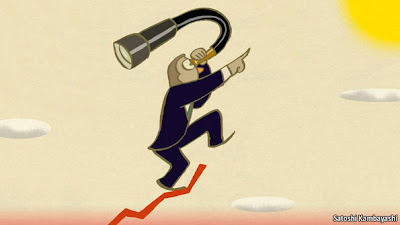The Missing Link
The Economist, 19-May-2011
Economic growth helps investors only if they are clairvoyant
IT MAY seem obvious that faster economic growth should translate into higher equity returns. So it was quite an upset when academics found some years ago that this had not been the case in advanced countries over the 20th century. A subsequent paper discovered that the story was similar for developing economies as well.
These findings are awkward for emerging-market enthusiasts, who usually cite the superior growth prospects of such countries as the reason to invest in them. The counter-attack has duly been led by Jim O’Neill of Goldman Sachs Asset Management, who as a strategist coined the wildly successful BRIC acronym for the big developing economies of Brazil, Russia, India and China. Yet the surprise is not only that the response has been so long in coming but that the case it makes is so limited.
The Goldman paper admits that there is no evidence that equity returns for any given year are correlated with GDP growth in that same year. But it says that “equity markets are a lead indicator of GDP growth and react strongly to expectations about the future.”
This conclusion is hardly new. Stockmarket movements are a standard component of economic lead indicators. But this link is of little use to investors, who are looking instead for a lead indicator for equity performance.
Goldman argues that investors can take advantage of upgrades in economic-growth forecasts, which signal better prospective returns especially in the developing world. But its evidence for this claim is quite limited (just ten years of data for Brazil and Mexico, for example). If one takes the American market over the past 40 years then there is a negative relationship between changes in growth forecasts and equity returns.
This raises another doubt about the Goldman analysis. It is rather dismissive of the long-term stockmarket returns compiled by Elroy Dimson, Paul Marsh and Mike Staunton of the London Business School (LBS), who published their findings in 2005. “Averaging over a century fails to account for potentially important structural breaks and changes in the way economies and markets operate,” the report says somewhat sniffily. But the data are the data; it is not scientific to leave out large chunks of evidence.
But what if superior GDP growth showed up in stockmarket returns not immediately but over a prolonged period? The LBS academics tackle this issue in their 2010 work, the “Credit Suisse Global Investment Returns Yearbook”. They take the records of 83 countries from 1972 to 2009 (the most comprehensive set available) and rank them by GDP growth over the previous five years. Investing each year in the countries with the highest economic growth over the preceding five years earned an annual return of 18.4%, but investing in the lowest-growth countries returned 25.1%.
The interesting question is why this phenomenon should occur. One explanation is that investors pile into the stockmarkets of high-growth countries until they become overvalued. That herd-like behaviour makes their subsequent returns disappointing.
Another possibility is that economic growth does not always get captured by the stockmarket. The fastest-growing companies are often unquoted: in emerging markets, for example, many businesses are family-owned or controlled by the state. Even when businesses are quoted, their growth may be financed by additional equity issuance that does not boost the returns of existing shareholders. One paper suggested that this effect could reduce returns by as much as two percentage points a year.
Although analysts often forecast annual profits growth of 10% or more, the LBS academics found that dividends failed to keep pace with GDP growth in every developed country (bar one) they studied between 1900 and 2009. Re-invested dividends are a vital component of long-term equity returns.
If investors could forecast future economic growth, then Goldman would be right: superior returns would be achieved. But there is precious little sign that such clairvoyance exists. And the evidence that past economic growth is of no help remains pretty compelling.
Monday, May 23, 2011
Subscribe to:
Posts (Atom)

